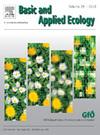Metabarcoding the night sky: Monitoring landscape-scale insect diversity through bat diet
IF 3.5
2区 环境科学与生态学
Q2 ECOLOGY
引用次数: 0
Abstract
Widespread declines of terrestrial insects are reported across habitats and are associated with drivers at the landscape scale. Current monitoring schemes survey insect communities mostly at local scales, while assessments of insect trends at the landscape scale are scarce. Insectivorous bats provide a feasible means to tackle this challenge, as they feed opportunistically on a wide variety of insects and other arthropods, while foraging in various habitats and thereby covering large distances between their roosts and hunting places. In this study, we analyzed the diet of a common European bat species (Pipistrellus pipistrellus) to investigate patterns in insect richness and composition at the landscape scale. We collected 24 fecal samples from 12 roosting places in Southern Germany and assessed insect richness and composition using DNA metabarcoding. We explored spatial and temporal variation in the diet of P. pipistrellus and quantified effects of landscape composition and configuration on insect species richness and composition using generalized linear models and non-metric multidimensional scaling. A total of 405 different insect and other arthropod species were identified in the fecal samples, with high proportions of Diptera (45 %), Lepidoptera (18 %), Coleoptera (13 %) and Hymenoptera (11 %), but also many other taxonomic groups. Species composition in the diet showed high variation in space and time, but was also associated with edge density and the proportion of grassland within 2 km radius of the roosts. Moreover, forest and grassland percentages within 2-km buffers around the roosts significantly increased species richness within the diet. Our study shows that genetic analysis of bat feces provides an efficient and promising approach to assess insect diversity patterns at the landscape level, and highlights the potential of widespread bat species for the monitoring of terrestrial insects at large scales.
夜空元条形码:通过蝙蝠饮食监测景观尺度昆虫多样性
据报道,整个栖息地的陆生昆虫普遍减少,并与景观尺度上的驱动因素有关。目前的监测方案主要是在地方尺度上调查昆虫群落,而在景观尺度上对昆虫趋势的评估很少。食虫蝙蝠为应对这一挑战提供了一种可行的方法,因为它们以各种各样的昆虫和其他节肢动物为食,同时在不同的栖息地觅食,从而在栖息地和狩猎地之间覆盖很远的距离。本研究对欧洲常见蝙蝠(Pipistrellus Pipistrellus)的饮食进行了分析,探讨了景观尺度上昆虫丰富度和组成的变化规律。我们从德国南部的12个栖息地收集了24份粪便样本,并利用DNA元条形码评估了昆虫的丰富度和组成。利用广义线性模型和非度量多维尺度,研究了pipistrellus食性的时空变化,并量化了景观组成和配置对昆虫物种丰富度和组成的影响。共鉴定出405种昆虫和节肢动物,其中双翅目(45%)、鳞翅目(18%)、鞘翅目(13%)和膜翅目(11%)所占比例较高,其他类群也较多。日粮中物种组成具有较高的时空变异性,但也与边缘密度和栖息地半径2 km范围内的草地比例有关。此外,栖息地周围2 km缓冲带内的森林和草地比例显著增加了饲料中的物种丰富度。本研究表明,蝙蝠粪便的遗传分析为在景观水平上评估昆虫多样性模式提供了一种有效而有前景的方法,并强调了广泛分布的蝙蝠物种在大尺度上监测陆生昆虫的潜力。
本文章由计算机程序翻译,如有差异,请以英文原文为准。
求助全文
约1分钟内获得全文
求助全文
来源期刊

Basic and Applied Ecology
环境科学-生态学
CiteScore
6.90
自引率
5.30%
发文量
103
审稿时长
10.6 weeks
期刊介绍:
Basic and Applied Ecology provides a forum in which significant advances and ideas can be rapidly communicated to a wide audience. Basic and Applied Ecology publishes original contributions, perspectives and reviews from all areas of basic and applied ecology. Ecologists from all countries are invited to publish ecological research of international interest in its pages. There is no bias with regard to taxon or geographical area.
 求助内容:
求助内容: 应助结果提醒方式:
应助结果提醒方式:


